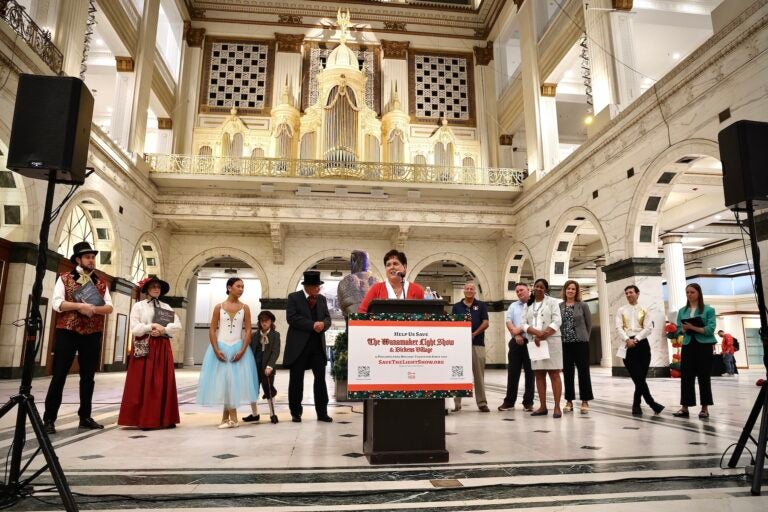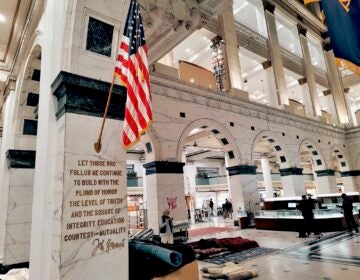Opera Philadelphia will take over Macy’s this fall
Philadelphia Visitor Center will also bring the Wanamaker Light Show back for the holidays.
Listen 1:15
Kathryn Ott Lovell, president and CEO of Philadelphia Visitor Center, announces a public fundraising campaign that will bring the Christmas light show and Dickens Village back to the Wanamaker Building this year, (Emma Lee/WHYY)
From Philly and the Pa. suburbs to South Jersey and Delaware, what would you like WHYY News to cover? Let us know!
The Wanamaker Organ at the former Macy’s store in Philadelphia will roar once again.
Two initiatives were announced Friday that will re-activate the now dormant retail space that once was home to a sprawling Macy’s department store. The annual Christmas light show and Dickens Village attractions will be revived during the holiday season, and Opera Philadelphia will program a series of events inside the empty store from September through December called Pipe Up!
Kathryn Ott Lovell, CEO of the Philadelphia Visitor Center, in partnership with the owner of the Wanamaker Building TF Cornerstone, has coordinated a fundraising campaign to raise $350,000 to bring back the holiday attractions inside the former Macy’s that have been beloved by Philadelphians and visitors for generations.
At the time of the announcement Friday morning, Ott Lovell said more than $200,000 had already been raised.
“When we found out Macy’s would be closing it was my first thought – and I’m sure many of yours: ‘What would happen to the light show and the Dickens Village?,’” Ott Lovell said at the announcement of the campaign.
“To imagine a future without this experience for my family, for your families was simply heartbreaking,” she said. “These aren’t just holiday attractions. They represent the heart of our holiday season and the spirit of our city.”
The Wanamaker Light Show was introduced in 1956 and estimates say it attracts hundreds of thousands of spectators to the Wanamaker Grand Court every holiday season. The Dickens Village walk-through tableau launched in 1985 at another department store, Strawbridge’s, then moved to Macy’s in 2006 when the former closed.

Philadelphia’s holiday traditions not only allow its residents to, in the words of a transformed Scrooge, “keep Christmas in my heart,” but also boost the city’s economy. Acting commerce director Karen Fegely said the city’s holiday attractions draw 400,000 downtown during the winter season
“Half of them are from outside Philadelphia,” she said. “That translates to an estimated $31.7 million dollars in total economic impact for the region. It’s clear to me that preserving these traditions is also about supporting jobs, small businesses and the long-term vitality of our city.”
The fall series “Pipe Up!” is supported by a $1 million grant from the Wyncote Foundation, which will allow Opera Philadelphia to hire additional staff to focus on programming the Wanamaker Building.
Opera general director Anthony Ross Costanzo said the “Pipe Up!” series is still in the planning stages but will feature partnerships with local performance groups such as Ballet X, the Bearded Ladies Cabaret, FringeArts and others yet to be announced
“I don’t know that we can fill all 400,000 square feet of the store,” Costanzo said. “However, there’s the historic Greek Hall, which is really beautiful with a theater organ, there’s the main space, and of course there’s the organ. There are some ancillary rooms where there used to be a makeup counter. We’re looking at what we can activate and how we can move people through the space.”

“Pipe Up!” will open with a concert Sept. 7 featuring the organ, called “Meet Me at the Eagle.”
When it was built in 1911, the Wanamaker Building was the largest retail building in the world. John Wanamaker, in a characteristic gesture of theatrical grandeur, bought the world’s largest pipe organ from the St. Louis World’s Fair and built it into his five-story center court.
Throughout many acquisitions and transitions, Wanamaker’s department store became Macy’s, which ultimately closed in March 2025. The future of the building is still undecided.
Constanzo described the scale of the building as “operatic.”
“An opera company represents every discipline, there’s theater, there’s poetry, there’s music, there’s art, there’s dance, there’s fashion, there’s film, there’s technology,” he said.
Costanzo called the act of bringing many kinds of art and performance into a single experience a Gesamtkunstwerk., which Merriam-Webster defines as “an art work produced by a synthesis of various art forms “such as music and drama.”
John Wanamaker called it a department store.
“He wanted that grand court to be the intersection of art and commerce,” Costanzo said.
“We’re doing this to look at new business models. How does a nonprofit and an arts organization thrive in today’s world? And how do we hold up our partners and our friends and bring them together? How are we getting people to engage with our product?” he said. “That is in the spirit of the department store that Wanamaker wanted to build.”
Costanzo saw an opportunity to bring Philadelphia’s art entities into collaborative performances and installations, inside a place that still holds tremendous cultural value to the city.
“In these times that we live in, art is a great way to grapple with things, to understand them, to feel joy, to come together,” he said. “There’s a lot happening every day, a lot to digest. We’re isolated, we’re looking at news. How do we come to grips with it? I think art is one of the answers.”
Editor’s Note: This story has been updated to reflect Kathryn Ott Lovell’s correct title.

Get daily updates from WHYY News!
WHYY is your source for fact-based, in-depth journalism and information. As a nonprofit organization, we rely on financial support from readers like you. Please give today.




